
West Newton is one of the thirteen villages within the city of Newton in Middlesex County, Massachusetts, United States.

The Jackson Homestead, located at 527 Washington Street, in the village of Newton Corner, in Newton, Massachusetts, is an historic house that served as a station on the Underground Railroad before the Civil War.

The Samuel Russell House is a neoclassical house at 350 High Street in Middletown, Connecticut, built in 1828 to a design by architect Ithiel Town. Many architectural historians consider it to be one of the finest Greek Revival mansions in the northeastern United States. Town's client was Samuel Russell (1789-1862), the founder of Russell & Company, the largest and most important American firm to do business in the China trade in the 19th century, and whose fortunes were primarily based on smuggling illegal and addictive opium into China.
Jackson House may refer to:

The West Newton Village Center Historic District encompasses the heart of the village of West Newton, in the city of Newton, Massachusetts in the United States. It extends along Washington Street between Lucas Court in the west and Davis Court in the east, and includes a few properties on immediately adjacent side streets, including Watertown Street and Waltham Street. The village is the second-largest of Newton's commercial centers and is the best-preserved of its late 19th and early 20th century village centers. The district was listed on the National Register of Historic Places in 1990.
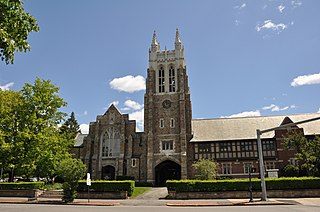
The First Unitarian Universalist Society in Newton occupies a prominent location at 1326 Washington Street in the heart of the village of West Newton in Newton, Massachusetts. Architect Ralph Adams Cram designed the church, Frederick Law Olmsted Jr. designed the grounds, the cornerstone was laid in 1905, and it was dedicated in 1906; it is one of the village's oldest buildings. The church is in Cram's signature Gothic Revival style, with buttressed walls and a blocky square tower with crenellations and spires. An enclosed courtyard is formed by an office wing, banquet hall, and parish house, which are built to resemble Elizabethan architecture with brick first floor and half-timbered upper level.

The Brackett House is an historic house located at 621 Centre Street in the Newton Centre village of Newton, Massachusetts. Built about 1844, it is a prominent local example of Greek Revival architecture, with a four-column temple front. Extensively damaged by fire in 2010, a careful restoration was completed in 2013. It was listed on the National Register of Historic Places on October 4, 1986.
East Parish Burying Ground, also known as Centre Street Burying Ground or Centre Street Cemetery, is an historic cemetery located at Centre and Cotton streets in the village of Newton Corner in the city of Newton, Massachusetts. On December 23, 1983, it was listed on the National Register of Historic Places. It has been called the "most important, the most evocative and also the most fragile historic site in the city."
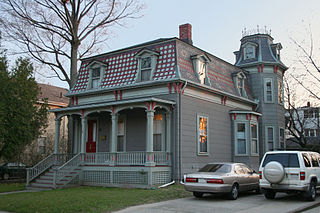
The Samuel Farquhar House is an historic Second Empire style building located in the village of Newton Corner in Newton, Massachusetts. The 1+1⁄2-story wood-frame house was built c. 1868. Its mansard roof is shingled in slate tiles of varying colors and shapes, arranged in decorative patterns. It has well-preserved decorative porch woodwork, and an octagonal 2+1⁄2-story turret at one corner. The roof lines are lined with dentil moulding with paired brackets. It is one of the finest Second Empire houses in the city.
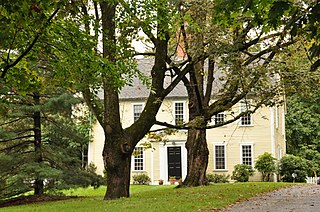
The Rev. Samuel Woodward House is a historic house located at 19 Concord Road in Weston, Massachusetts. Built in 1753, it is a well-preserved example of mid-18th century Georgian architecture. It has also been home to a succession of people significant to the history of the town. It was listed on the National Register of Historic Places in 1976, and was included in Weston's Boston Post Road Historic District in 1983.
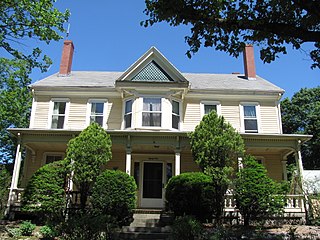
The Carter Mansion is a historic house located in Reading, Massachusetts.

The Samuel Bancroft House is a historic house in Reading, Massachusetts. With an estimated construction date of 1748, it is one of the town's older surviving houses, and one of a small number from the late colonial period. It was listed on the National Register of Historic Places in 1984.

The Samuel Parker House is a historic house in Reading, Massachusetts, United States. The front, gambrel-roofed portion of this house, was probably built in the mid-1790s, and the house as a whole reflects a vernacular Georgian-Federal style. The house is noted for a succession of working-class owners. Its most notable resident was Carrie Belle Kenney, one of the earliest female graduates of the Massachusetts Institute of Technology.
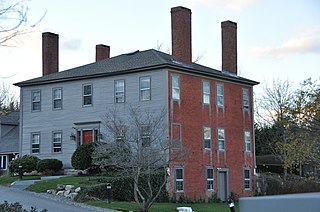
The Thomas Symonds House is a historic house at 320 Haverhill Street in Reading, Massachusetts. Built sometime between 1775 and 1836 by Thomas Symonds, Jr., it is the only Federal period brick-ended house in the town, and is unusually architecturally sophisticated for the period in the town. The house was listed on the National Register of Historic Places in 1984.

The Adams Claflin House is a historic house at 156 Grant Avenue in the village of Newton Centre in Newton, Massachusetts. It is a large 2+1⁄2-story cross-gable wood-frame structure, built in the Shingle style to a design by Samuel Brown for Adams Davenport Claflin. Claflin was the son of Massachusetts Governor and Newtonville resident William Claflin, and was a major landowner in Newtonville as well as president of the Boston and Suburban Electric Company. Claflin was a major developer of the streetcar system that served Newton. Architecturally, the house shows vestiges of the Queen Anne style, with its asymmetrical massing and wealth of projections and gables, as well as elements of the Colonial Revival, exemplified by a Palladian window, and by the pedimented front porch. The house is one of several designed by Brown for the Claflin family.
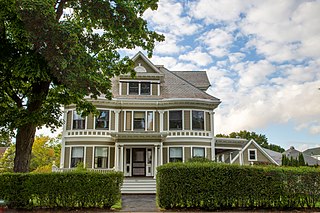
The House at 511 Watertown Street in Newton, Massachusetts is one of the city's finer Colonial Revival houses completed in 1897. The house was listed on the National Register of Historic Places in 1986 and is on the border of two of Newton's older villages: Newtonville and Nonantum.

The Jackson House is a historic house at 125 Jackson Street in Newton, Massachusetts. The 2+1⁄2-story timber-frame house was built either c. 1768 or c. 1782, and is one of Newton's few surviving 18th-century farmhouses. A house is known to have been on the property c. 1768, but the present house use construction methods and styling more common to a later period in the 18th century, suggesting a c. 1782 construction date. It was restyled in the 1850s to give it Greek Revival features.

The James Lorin Richards House is an historic house and carriage barn in Newton, Massachusetts. The house is located at 47 Kirkstall Road and the carriage barn, which has been converted to a residence, is at 22 Oakwood Road. The high-style Shingle buildings were designed by Samuel J. Brown and built in 1901 for James Lorin Richards, a successful businessman who made his fortune in tobacco, and was heavily involved in Boston-area electric companies. He also served as president of Norumbega Park, a major early-20th century amusement park in Newton.

The Samuel Wheat House is a historic house at 399 Waltham Street in Newton, Massachusetts. It is a 2+1⁄2-story timber-frame house, five bays wide, with a gambrel roof and clapboard siding. The front entrance is flanked by pilasters and topped by a gabled pediment. The house was built c. 1735, probably for Dr. Samuel Wheat, Jr, and is one of the oldest houses in the city. It was probably built with the gambrel roof, but the dormers are a 19th-century addition.

The Dr. Samuel Warren House is a historic house in the West Newton village of Newton, Massachusetts. The oldest part of the house, its southern portion, was built c. 1716 by William Williams, an early settler of the area, and expanded to its present size around 1751. It was originally located near Washington Street, but was moved to its present location in the second half of the 19th century. The building has had a succession of owners prominent in the development of West Newton, including the physician Dr. Samuel Warren and the educator Nathaniel Topliff Allen. It was converted for use as professional offices in 1960.




















